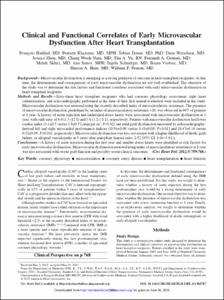KUMEL Repository
1. Journal Papers (연구논문)
1. School of Medicine (의과대학)
Dept. of Internal Medicine (내과학)
Clinical and Functional Correlates of Early Microvascular Dysfunction After Heart Transplantation
- Keimyung Author(s)
- Nam, Chang Wook
- Department
- Dept. of Internal Medicine (내과학)
- Journal Title
- Circulation: Heart Failure
- Issued Date
- 2012
- Volume
- 5
- Issue
- 6
- Abstract
- Background—Microvascular dysfunction is emerging as a strong predictor of outcome in heart transplant recipients. At this time, the determinants and consequences of early microvascular dysfunction are not well established. The objective of the study was to determine the risk factors and functional correlates associated with early microvascular dysfunction in heart transplant recipients.
Methods and Results—Sixty-three heart transplant recipients who had coronary physiology assessment, right heart catheterization, and echocardiography performed at the time of their first annual evaluation were included in the study. Microvascular dysfunction was assessed using the recently described index of microcirculatory resistance. The presence of microvascular dysfunction, predefined by an index of microcirculatory resistance >20, was observed in 46% of patients at 1 year. A history of acute rejection and undersized donor hearts were associated with microvascular dysfunction at 1 year, with odds ratio of 4.0 (1.3–12.8) and 3.6 (1.2–11.1), respectively. Patients with microvascular dysfunction had lower cardiac index (3.1±0.7 versus 3.5±0.7 L/min per m2; P=0.02) and mild graft dysfunction measured by echocardiography-derived left and right myocardial performance indices ([0.54±0.09 versus 0.43±0.09; P<0.01] and [0.47±0.14 versus 0.32±0.05; P<0.01], respectively). Microvascular dysfunction was also associated with a higher likelihood of death, graft failure, or allograft vasculopathy at 5 years after transplant (hazard ratio, 2.52 [95% CI, 1.04–5.91]).
Conclusions—A history of acute rejection during the first year and smaller donor hearts were identified as risk factors for early microvascular dysfunction. Microvascular dysfunction assessed using index of microcirculatory resistances at 1 year was also associated with worse graft function and possibly worse clinical outcomes.
Key Words: coronary physiology
microcirculation
coronary artery disease
heart transplantation
heart function
- Keimyung Author(s)(Kor)
- 남창욱
- Publisher
- School of Medicine
- Citation
- François Haddad et al. (2012). Clinical and Functional Correlates of Early Microvascular Dysfunction After Heart Transplantation. Circulation: Heart Failure, 5(6), 759–768. doi: 10.1161/CIRCHEARTFAILURE.111.962787
- Type
- Article
- ISSN
- 1941-3289
- Appears in Collections:
- 1. School of Medicine (의과대학) > Dept. of Internal Medicine (내과학)
- 파일 목록
-
-
Download
 oak-aaa-00950.pdf
기타 데이터 / 789.61 kB / Adobe PDF
oak-aaa-00950.pdf
기타 데이터 / 789.61 kB / Adobe PDF
-
Items in Repository are protected by copyright, with all rights reserved, unless otherwise indicated.